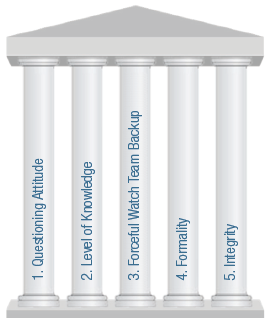OEMS is only part of the equation in the greater goal of achieving Operational Excellence. The other part of the equation is a culture built on Operational Discipline, but because it involves culture and is less tangible than an OEMS, Operational Discipline can be difficult to define and explain. And, of course, this makes it challenging to communicate and actively demonstrate Operational Discipline within your organization to develop a culture that can effectively implement and use the 7 Element OEMS. There is a parallel in the relationship between strategy and OE that we discussed in earlier blogs – either one alone is not enough. The same is true in the relationship between OEMS and Operational Discipline for achieving OE. Having a system that helps your organization align itself to execute its strategy accomplishes nothing if the organization does not have a culture that supports understanding, using and improving that system.
A robust OEMS alone will not lead to Operational Excellence; a culture of Operational Discipline that drives the 1) understanding of 2) adherence to 3) questioning of and 4) enforcement of the OEMS is integral to achieving Operational Excellence.
Operational Discipline, as we define it and most others would agree, is “doing the right thing, the right way, every time.” That is a pretty simple definition, but when you start thinking through the implications of what it takes for employees to be properly equipped AND have the motivation to do that, things get more complicated. If you break down the definition, you see there are three areas of focus needed to drive the right behaviors of Operational Discipline:
1. Know what the right thing to do is
2. Be willing to always do the right thing
3. Ensure others also always do the right thing
Equipping employees to know the right thing and do the right thing every time requires guiding principles that govern their actions and behaviors – what we call the 5 Pillars of Operational Discipline. Through our experience in this space across a number of industries and in the US Navy, we have identified the 5 Pillars of Operational Discipline – these pillars are the beliefs and behaviors that must be exhibited to ensure employees “do the right thing, the right way, every time.”
You can see how the 5 Pillars actually drive the behaviors mentioned earlier. Level of Knowledge and Questioning Attitude help employees know and understand what the right thing to do is. Integrity and Formality support employees’ willingness to do the right thing themselves. Forceful Watch Team Backup is there to ensure that employees are also concerned with ensuring others also do the right thing all the time.
In future posts we will explore the 5 Pillars in greater depth and discuss how they are interrelated and self-reinforcing. A key to remember when trying to drive a cultural shift within your company is that requiring certain activities is not enough; people must understand the intent of those activities and believe in the underlying rationale.


